 Widok zawartości stron
Widok zawartości stron
 Widok zawartości stron
Widok zawartości stron
 Widok zawartości stron
Widok zawartości stron
 Widok zawartości stron
Widok zawartości stron
 Widok zawartości stron
Widok zawartości stron
 Widok zawartości stron
Widok zawartości stron
Sponsors
Partners

The EPIP Association is a beneficiary of a grant from the European Intellectual Property Office (EUIPO) under decision #1320220004 to support the understanding of IP economics and benefit local organisers running the annual conference.
EPIP2023 has been supported by a grant from the Faculty of Law and Administration under the Strategic Programme Excellence Initiative at Jagiellonian University.
 Widok zawartości stron
Widok zawartości stron
Auditorium Maximum
The description was prepared by the Disability Support Service.
Auditorium Maximum UJ is located at 33 Krupnicza Street. It is situated parallel to the street, with a strip of separate parking spaces and a pavement made of cobblestones. The pavement is separated from the car spaces by concrete posts. The building is located in a compound of buildings belonging to the Jagiellonian University: from the side of Mickiewicza Avenue, it neighbours the Paderevianum II; from the other side, it is almost surrounded by the Didactic Centre of the Faculty of Law and Administration.
Auditorium Maximum is a modern, expansive four-storey building with a façade in a muted colour scheme of dark clinker and numerous glass surfaces incorporated into it. The building serves a representative function. As a conference and teaching facility, it hosts not only students but also participants of conferences, symposia, fairs, exhibitions and even concerts. On the right-hand side of the façade, we can see seven masts on the pavement, onto which flags or banners are hoisted depending on the needs and circumstances.
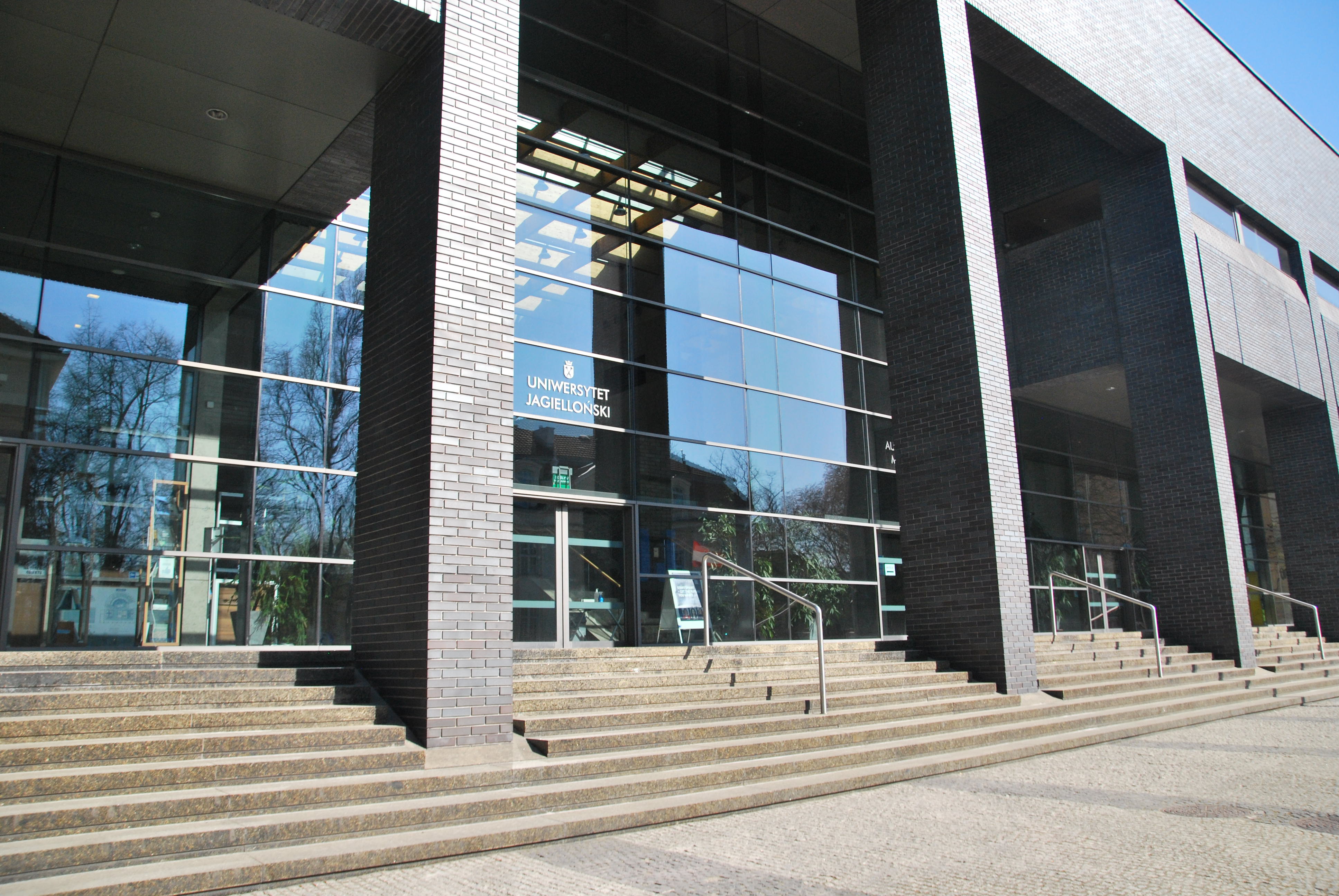
The glazed façade is preceded by an arcade, accessed by climbing seven steps. According to the designer's concept, both the function and form of the building draw on classical models. Eight columns form the arcades, so there are seven fields in the colonnade - the entrance spaces. There are stair railings in the middle of each field between the columns. The two handrails from the left side of the façade start at the first step, the others at the fourth step. The two central fields (with handrails from the fourth step) lead to the main entrance. The other lead to the arcade. There are two more sliding doors on two sides of the main entrance, but these usually function as emergency exits and are closed for those entering the building.
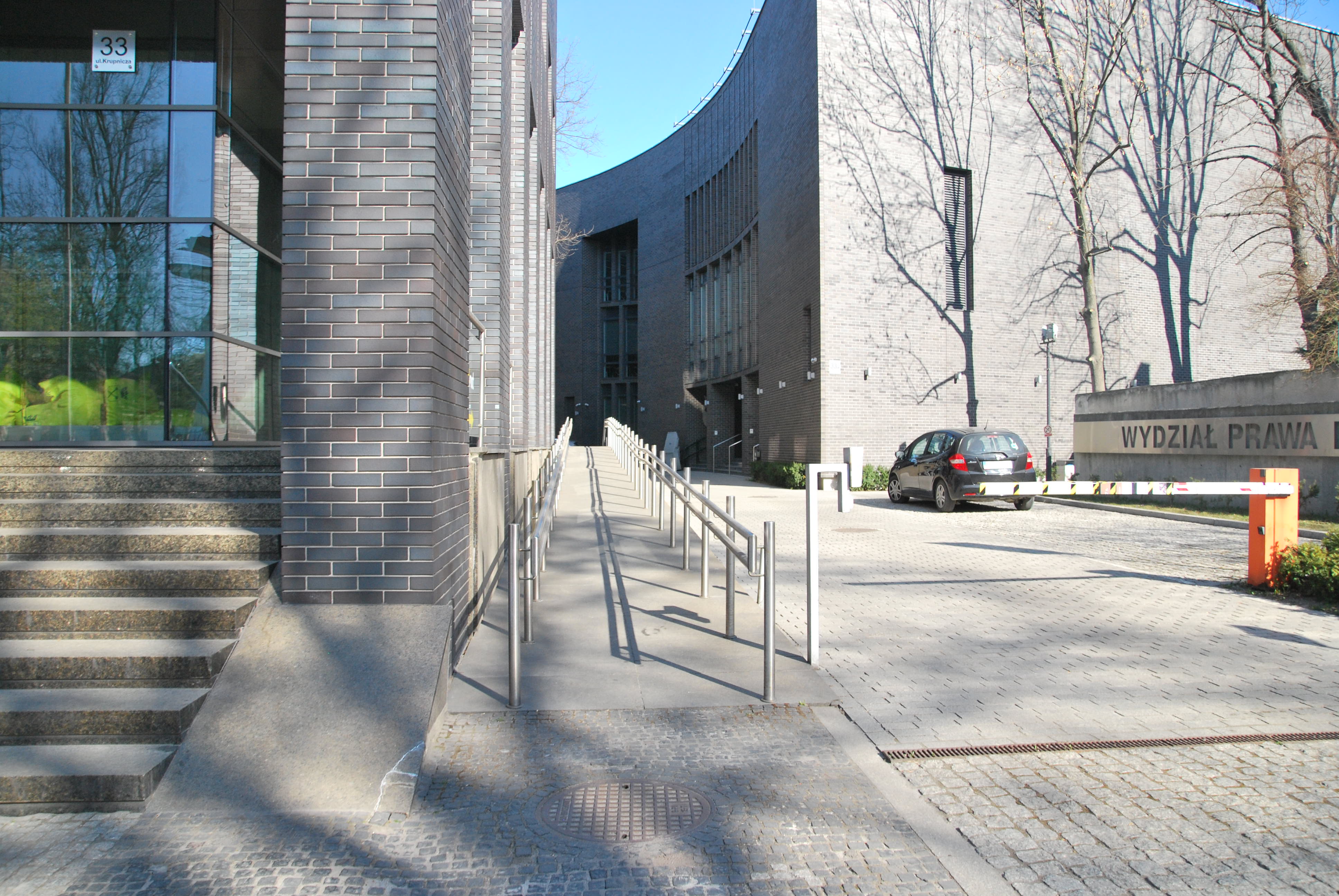
The ramp for wheelchair users is on the right side of the building, on the corner near the Didactic Centre of the UJ Faculty of Law and Administration. After negotiating the ramp, we find ourselves at the entrance level, moving to it along the arcade. The main entrance is a double-glazed automatic sliding door in the middle of the facade. Upon entering, we find ourselves at level 0 in the lobby. Then, heading slightly to the left, we reach the porter's lodge behind a counter and a glass window.
The building has three above-ground floors and one underground floor (car park).
Each floor can be accessed by stairs or a lift. For this description, the terms left and right will be oriented relative to the lifts. If we consider the lifts as central points of the building, we can imagine that the description of the building will be built around corridors diverging in two directions with entrances to individual halls and rooms.
There are two lifts in the building. Both serve levels from minus one (underground car park) to three. You will reach them when you head slightly left and straight ahead after entering the building. At the end of the hall, in a space hidden somewhat behind a broad, representative marble staircase, is the first lift door; further to the right, on the same wall at a distance of about 5 metres, we have the entrance to the second lift (we can also reach this lift directly by walking through the cloakroom located on level 0). The lifts are equipped with voice announcements in Polish and English, buttons in Braille, mirrors and handrails.

The description of level 0 will be led from the main entrance. Facing the entrance to the building, one first encounters a wide marble staircase with warning markers on the edges, leading to the upper levels. The staircase is divided in the middle by a handrail. Handrails are also found on the sides of the stairs. To the right of the staircase, we find the entrance to the cloakroom, a double glass door, usually open during events held in the building, through which we enter a long, narrow room. Rows of hangers are to the right behind a long counter. The cloakroom is operated by designated staff. To the left, a mirror is hung about 120 cm high on the door leading to the technical room. You can walk the entire length of this room and, at its end, reach a door leading directly into the corridor opposite one of the lifts.
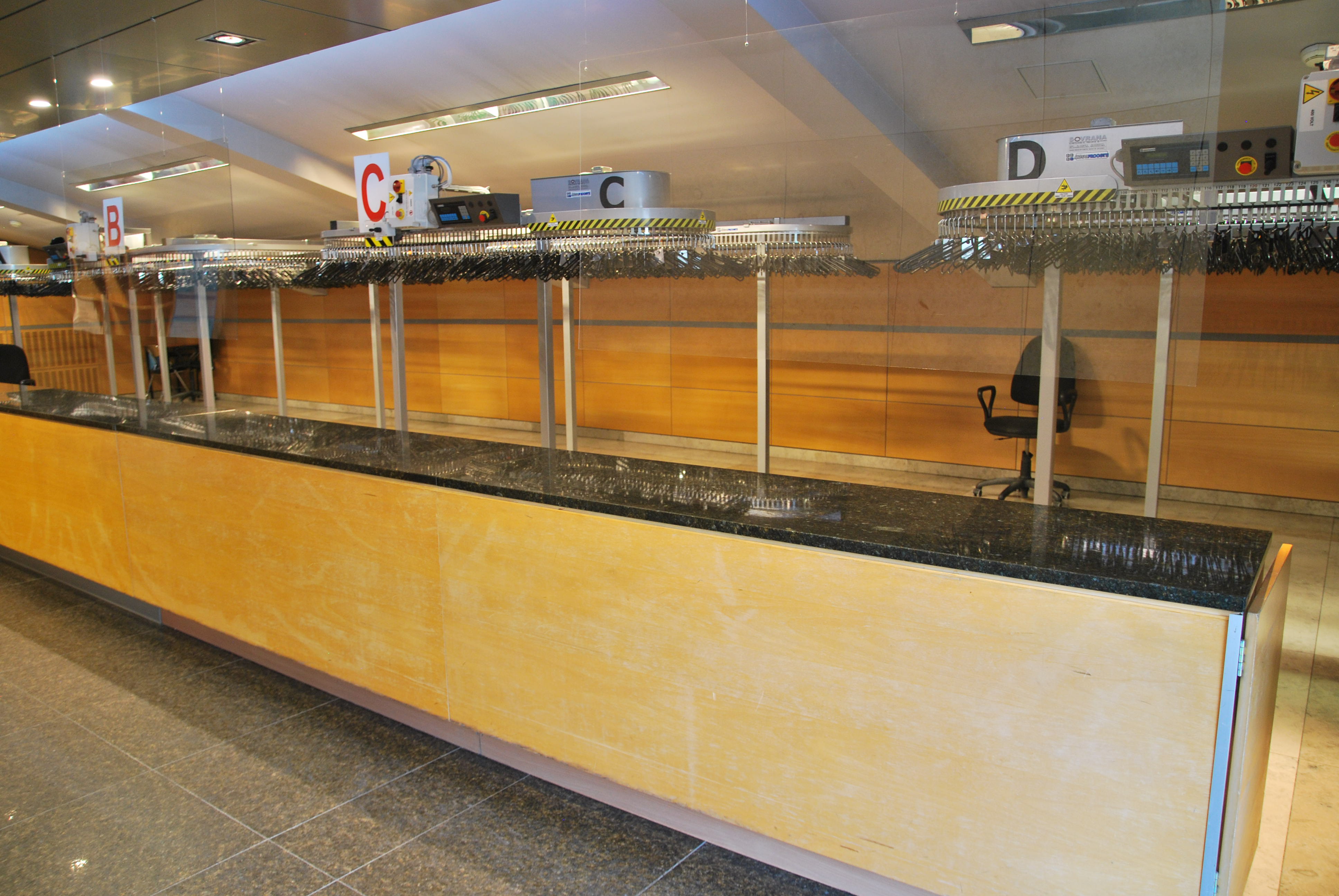
As you pass the cloakroom and continue to the right, you pass a tall rack of newspapers and leaflets standing against the wall, behind which the floor plans of each floor are hung on the wall with colour distinctions for each room. Further along, on the left-hand side of the corridor, there is a single manual-opening door leading to the Medium Hall A (both the Medium and Large Hall, as well as the Seminar Hall and Exhibition Hall, described further on, can be divided into two parts by means of mobile acoustic panels. When a room functions as divided, we refer to parts A and B, the halls then having separate entrances). The corridor ends just after the entrance to Medium Hall A, on the other side of which pots with tall plants are arranged under glass surfaces.
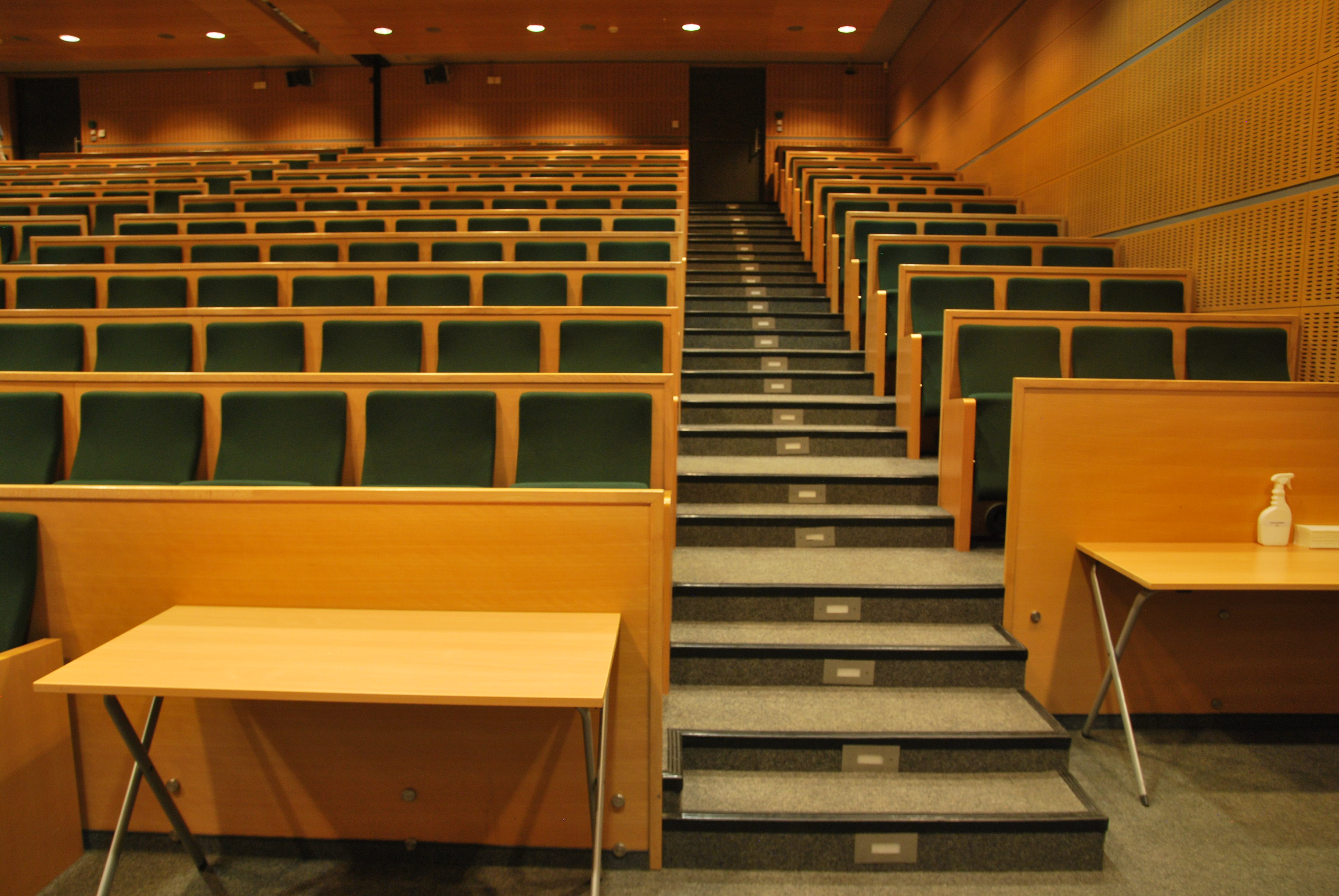
To the left of the entrance, in an alcove between the glass wall of the façade and the gatehouse, just to the right of the wall, there is a narrow staircase leading to the administration rooms, the only space in the building inaccessible for people with disabilities. However, just behind these stairs, behind a double glass door, a fully accessible room is designated where meetings can take place, for example, with the building administrator, or where other administrative matters can be dealt with if required.
After exiting this corridor, we pass the gatehouse on our left; as we head straight into this part of the building, we encounter a single door on our left - the entrance to the Small Hall, with a second door also leading to the Small Hall located about 4 metres apart. Behind them, against the wall on the left, we pass the snack and beverage vending machines, and finally, we reach the door to the Large Hall A. From here, the corridor leads to the left. Passing through double glass doors, we find ourselves in a section leading to the restrooms and further to the bistro. On the left side of the corridor, in an alcove, the entrances to the restrooms are located: the women's restrooms are on the left (sinks on the left, five cubicles on the right), opposite - the restrooms adapted to the needs of people with disabilities, on the right - the men's restrooms (sinks on the right, five cubicles on the left). On exiting the restroom space, to the right, a ramp with handrails on both sides is accessible, leading to the bistro. At the end of the corridor, on the right, we have the entrance to the staircase and, opposite, a glass door - an emergency exit to the outside on the arcade level.
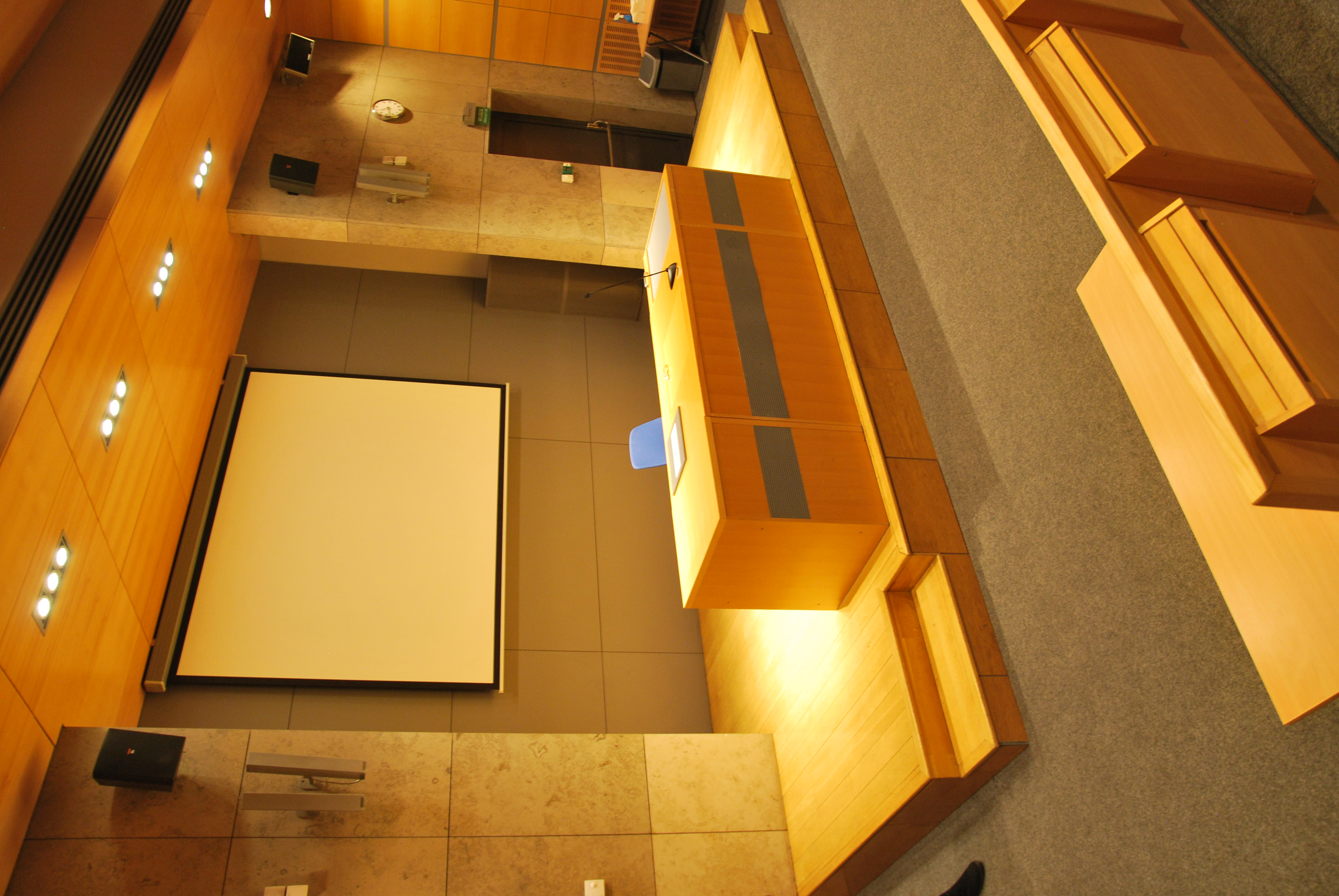
When you return from this corridor to the main hall, you bypass the slightly rounded wall of Large Hall A and find yourself at the lift. Heading left from the lift, we pass: on the right, the entrances to the administration and staff rooms, on the wall on the left, a second lift and reach a fork in the corridor. Turning slightly to the left, straight ahead, we reach the entrance to Large Hall B. Continuing onwards, we encounter a staircase (seven steps with a handrail on the right) and a lower passage to the cafe on the left. On returning to the fork, a short corridor opens up on the right, topped by an exit to a staircase. On the right here, against the wall, we have a row of chairs, followed by the door to Medium Hall B.

Opposite the lift is a wide marble main staircase with a handrail. As you head left from here, you will encounter a row of five chairs against the wall on the left, then a second lift. Opposite this lift is the entrance to the corridor leading to Medium Halls A and B. The first door on the left in this corridor is Medium Hall B; the next is Medium Hall A. At the end of the corridor is a glass wall overlooking the main entrance to the building and part of the ground floor hall. After exiting this corridor, when you turn slightly left after the lift, you reach another corridor separated by double glass doors that open manually. This corridor leads to the entrance of the Large Hall B, the door to which is on the left; also, on this side, chairs are located against the wall behind the door. At the end of the corridor is the exit to the staircase. On the opposite side of the corridor is a glass space overlooking the Auditorium Maximum patio. On exiting this corridor, we have a small alcove on the left with a row of chairs on the right against the wall.
As we head to the right from here, we pass the lifts again and, turning right behind them, we reach a door leading into a corridor; opposite the door, behind the glass is a view of the amphitheatre-style Large Hall. Moving on, we pass into an alcove to the left of the restrooms. Analogous to level 0, the alcove contains: on the left - the ladies' restroom (sinks on the left, five cubicles on the right), opposite - the restroom adapted for people with disabilities, on the right - the men's restroom (sinks on the right, five cubicles on the left). After leaving the restroom space on the right, we arrive at the door to the Large Hall B. At the end of the corridor on the right, we have an exit to the stairwell.
When we head to the left after exiting the lift on the second floor, just like on the lower floor, about 5 metres further on the same wall, we come to the second lift. You can imagine that this part to the left of the lift is located, so to speak, around the patio. As a result, we have a bifurcation into the two corridors, with the patio area visible behind the glass area from each floor in between.
When we turn slightly to the left after the lift, we reach a corridor separated by double glass doors that open manually. Straight ahead, after passing through the door, there is a glass window through which part of the Large Hall is visible. Next, the first door on the left is the entrance to Interpreter Cabin B. Further on, some chairs are against the wall. The next door is the exit to the staircase. Behind them, the corridor bounces to the left, at the end of which is the door to Large Hall B. On the opposite side of the corridor is a glazed area overlooking the Auditorium Maximum patio. At the end of this glazed area, there are also several chairs.
On leaving this corridor, to the left, in a small side corridor, are the entrances to the Exhibition Hall - to reach the entrance to Exhibition Hall A, head left. The door is on the right side of the corridor. Head right to reach the entrance to Exhibition Hall B. The door is on the left side of the corridor.
Returning to the main hall, when you exit the lift, head right; you will reach the door leading into the corridor. Opposite the door behind the glass, you will have a view of the amphitheatre-like Large Hall.
After returning to the main corridor of this part of the building, as you continue walking, you pass the restrooms in the alcove on the left. Analogous to the lower levels, the alcove contains: on the left - the ladies' restroom (sinks on the left, five cubicles on the right), opposite - the restroom adapted for people with disabilities, on the right - the men's restroom (sinks on the right, five cubicles on the left). On exiting the restroom space to the right, you will find the door to Interpreter Cabin A. Further to the right - exit to the stairwell. At the end of the corridor, on the right, there is an alcove equipped with chairs standing on the right against the wall. The alcove leads us to the entrance of Large Hall A.
When we head to the left after exiting the lift on the third floor, as on the lower floors, about 5 metres further on the same wall, we come to a second lift. Just after this lift, turning slightly left, we reach a corridor that leads us to the B balcony of the Large Hall. Walking along the corridor on the right, all the time, we have a glass space with a railing at the shafts and a view of the patio. The first door on the left leads to Interpreter Cabin B, then the exit to the staircase. Further on, after climbing three stairs up, we are at the level of the entrance to the balcony, and this entrance itself is located deep in the small corridor on the left. After exiting this corridor, we have a small alcove on the left, ending in an exit to the staircase at its end.
As we head to the right from here, we pass the lifts again on the left and a marble balustrade on the right, behind which the view from above opens up to the stairs and the ground floor hall. Turning right after the lifts, we reach a door leading to a corridor that leads to the balcony of Large Hall A. The first door on the left is an enclosed service room, followed by an alcove with restrooms. Analogous to the lower levels, the alcove contains: on the left - the women's restroom (sinks on the left, five cubicles on the right); opposite - the restroom adapted for people with disabilities; on the right - the men's restroom (sinks on the right, five cubicles on the left). The door on the right of the corridor is Interpreter's Cabin A, then exit to the stairwell. On the right at the end of the corridor, after climbing three stairs up, you enter the entrance level to the balcony of the Large Hall A. This entrance is in front of you.
- Cloakroom
- level 0
- Small Hall
- level 0
- Medium Halls A and B (amphitheatre-style, 268 seats, can be divided into two sections of 134, hence A and B)
- level 0
- level 1
- Large Halls A and B (amphitheatre-style, 1200 seats, can be divided into two sections of 600, hence A and B)
- level 0
- level 1
- level 2
- Exhibition Hall A and B
- level 2
- Interpreter Cabins A and B
- level 2
- level 3
- The balcony of the Large Halls A and B
- level 3
There is no public parking in front of the Auditorium Maximum. You can park on the street (charged as for subzone A of the Paid Parking Zone). The nearest larger car park is at the National Museum.
Parking spaces for people with disabilities are available around the building:
- one space in the underground garage - entry is possible from Krupnicza Street, between Collegium Paderevianum II and Auditorium Maximum. After descending to level minus one, the parking space for persons with disabilities is directly opposite. It is the first space on the right, opposite the lift. To access the building from this space, cross to the other side of the vehicle lane. There the door to the building is located straight ahead. Just behind it, further ahead, is the lift.
- two external parking spaces are located on the side of the Didactic Centre of the Faculty of Law and Administration of the Jagiellonian University at 33A Krupnicza Street, just after the exit from Krupnicza Street, on the right behind the barrier (these are common spaces with the Didactic Centre of the Faculty of Law and Administration of the Jagiellonian University),
- one parking space - also external - parallel to the pavement, between the Auditorium Maximum and the Mickiewicza 9A building (shared with the other buildings of the Paderevianum complex).
Access to the AGH/UR bus stop, directly adjacent to the Auditorium Maximum of the Jagiellonian University, is possible by bus lines: 179 and 304 (from the Dworzec Główny Zachód stop). Travel time approx. fifteen minutes + 300 metres on foot.
There is also a Batorego stop nearby. Access is possible by trams lines: 4, 14, and 24 (from the Słowackiego Theatre stop). Travel time approx. five minutes + 500 metres on foot.
Low-floor vehicles are marked with the symbol of a person in a wheelchair on the entrance doors and on information boards at stops. The boards are equipped with a voice announcement system. Most trams and a large share of buses are equipped with a voice announcement system.
You can purchase tickets at ticket machines at stops (payment by card and cash), at ticket machines in vehicles (payment by card or cash depending on the vehicle) and using one of the mobile applications: iMKA, mPay, moBiLET, SkyCash, jakdojade or zbiletem.pl. The public transport operator publishes a ticket guide.
The Auditorium Maximum building is a dog-friendly place for assistance dogs. There is a possibility to communicate in Polish sign language in the building upon prior request.
 Widok zawartości stron
Widok zawartości stron
fot. of Kraków: Paweł Litwiński
